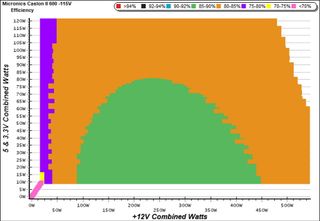Micronics Caslon II 600W PSU Review: A Low-Cost Gem?
Why you can trust Tom's Hardware
Cross-Load Tests & Infrared Images
Our cross-load tests are described in detail here.
To generate the following charts, we set our loaders to auto mode through our custom-made software before trying more than 25,000 possible load combinations with the +12V, 5V, and 3.3V rails. The load regulation deviations in each of the charts below were calculated by taking the nominal values of the rails (12V, 5V, and 3.3V) as point zero. The ambient temperature was between at 30°C (86°F) to 32°C (89.6°F).
Load Regulation Charts



Efficiency Chart

The PSU achieves greater than 85% efficiency from 90W to 450W load on the +12V rail, so long as load on the minor rails stays below 80W. You shouldn't expect more from an outdated platform.
Ripple Charts




Infrared Images
We applied half-load for 10 minutes with the PSU's top cover and cooling fan removed before taking photos with our modified FLIR E4 camera that delivers 320x240 IR resolution (76,800 pixels).









Temperatures inside of the Caslon II are high due to its low efficiency. This proves that a loose fan profile was simply not an option during this PSU's design.
MORE: Best Power Supplies
MORE: How We Test Power Supplies
MORE: All Power Supply Content
Current page: Cross-Load Tests & Infrared Images
Prev Page Protection Features Next Page Transient Response TestsStay on the Cutting Edge
Join the experts who read Tom's Hardware for the inside track on enthusiast PC tech news — and have for over 25 years. We'll send breaking news and in-depth reviews of CPUs, GPUs, AI, maker hardware and more straight to your inbox.
Aris Mpitziopoulos is a Contributing Editor at Tom's Hardware US, covering PSUs.
-
nobspls Why would anyone choose this one say over the Corsair CX650M? Which you can get typically for $50.Reply -
spentshells " Not only does this minimize your carbon footprint"Reply
The idea of conserving electricity is a fallacy, if you use less the people selling can sell more to someone else..... they aren't just holding on to the energy you saved because you're a hero saving the world.
Making your footprint smaller doesn't matter in the least when someone else's foot print just gets that much bigger.
Save some money, sure but for how long? The less you use the more they can charge for that smaller amount later on..... that's how it is.
On a different note, Ill likely try the psu out at one point on a build for someone else. -
rohs42 > The idea of conserving electricity is a fallacyReply
No it isn't. Of course a 100 megawatt generator will not be turned off if someone saves 10 watts of power. But if a 10 million people save 10 watts of power, then of course it will be turned off. And if 100 million people save 10 watts, then there'll be no business case for that new gigawatt power plant.
As citizens, consumers and voters we all bear a small share of responsibility for the state of the world, and we all have a small part to play in making it better. It's only through working together that humanity improves. Your appeal to helplessness and apathy is pathetic. -
jabliese Hey Tom's,Reply
Once upon a time, we had an extensive brown out at work, which went on for 3 days. On day 2, I was surprised to find many of the PC's that were still working were on 60v power. Over the years, it did not seem to have a adverse affect on any of the power supplies. Lately, I have been wondering what their efficiency numbers looked like during that time, any chance you could add a severe undervolt test to the power supply suite? -
Aris_Mp 60V is too low. Most PSUs won't even work at such low voltage. I am surprised to hear that the PSUs at your work were working under such conditions for days.Reply
Efficiency drops along with voltage input. I want to add more protection tests, however I already have enough fails with the current ones. Nonetheless, I am keeping every suggestion under consideration.